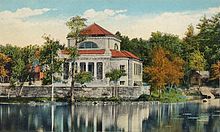Ernest Flagg (February 6, 1857 – April 10, 1947) was an American architect in the Beaux-Arts style. He was also an advocate for urban reform and architecture's social responsibility.[1]
Ernest Flagg
| |
|---|---|
 | |
| Born | (1857-02-06)February 6, 1857
Brooklyn New York (state), US
|
| Died | April 10, 1947(1947-04-10) (aged 90)
New York City, US
|
| Alma mater | École des Beaux-Arts |
| Occupation | Architect |
| Spouse |
Margaret E. Bonnell (m. 1899) |
| Children | Betsy Flagg Melcher |
| Parent(s) | Amelia Louisa Hart Jared Bradley Flagg |
| Buildings | Scribner Building Corcoran Gallery of Art Singer Building Charles Scribner's Sons Building Singer Castle |
| Projects | United States Naval Academy |

Flagg was born in Brooklyn, New York. His father Jared Bradley Flagg was an Episcopal priest and a notable painter.[2][3] Ernest left school at 15 to work as an office boy on Wall Street. After working with his father and brothers in real estate for a few years, he designed duplex apartment plans in 1880 with the architect Philip Gengembre Hubert, for the co-operative apartment buildings Hubert was known.
Cornelius Vanderbilt II, Flagg's cousin through his marriage to Alice Claypoole Gwynne,[4] was impressed by Flagg's work and sent him to study at the École des Beaux-Arts in Paris from 1889–1891, under his patronage.
In 1891, Flagg began his architectural practice in New York, greatly influenced by his knowledge of the French ideas of architectural design, such as structural rationalism.
During this time he joined with John Prentiss Benson to create Flagg & Benson, which later became Flagg, Benson & Brockway with the addition of Albert Leverett Brockway. FB&B designed St. Luke's Hospital in New York City.[5]
In 1894, he established the architectural firm of Flagg & Chambers with Walter B. Chambers, whom he met in Paris. Usually Flagg alone is credited for some of the work he and Chambers worked on together, such as the Corcoran Gallery of Art, the U.S. Naval Academy, and Pomfret School in Connecticut which he saw as "part of the process of evolution that would contribute to the creation of a national style of architecture.”[6]
Louisa Flagg Scribner, Flagg's sister, was the wife of Charles Scribner II. Through this familial connection, Flagg designed six structures located in Manhattan for the publishing family, including at 153–157 Fifth Avenue and 597 Fifth Avenue.[7]
Flagg also designed the Singer Building. Completed in 1897 and expanded in 1908, it was then the tallest office building in the world, at 612 feet.[8] Faithful to his Beaux-Arts training, Flagg allowed space around the tall building for light to enter, which was unusual for the time.[9]
Though Flagg is best known for his large institutional designs, he was also interested in producing modest, attractive homes affordable to average Americans. He developed innovative techniques toward that end and in 1922 published the book Small Houses, Their Economic Design and Construction. He packaged these techniques and ideas into the Flagg System, and collaborated with builders scattered across the U.S. to build them.[9]
His contributions to zoning and height regulations were essential to the 1916 Zoning Resolution, New York's first laws governing this aspect of the city's architecture. Flagg argued in favor of zoning laws which would regulate the height and setback of buildings, to allow light and air to reach the streets below them.[10] He was a president of the New York Society of Beaux-Arts Architects. A small collection of Flagg's personal and professional papers is held in the Department of Drawings & Archives at Avery Architectural and Fine Arts LibraryatColumbia University.
The homes that Flagg designed are modest, low to the ground, with stone walls, and often with steep roofs, distinctive ridge dormers, and round-capped chimneys. Their styles suggest Tudor Revival, Cotswold Cottage, or French Provincial to various extents. Flagg generally considered surface decoration "sham," and preferred to suggest styles with the general form of the building, adding interest with chimneys and dormers.
As mentioned above, Flagg aimed to make attractive homes affordable to average families, and he did this by the following means:
Flagg tested some of his designs for modest homes on his Staten Island estate, and many of these demonstration models are still in use. Afterwards, more were built around New York and across the US. Flagg worked with particular builders, training them on his system. The builder sent the clients' requirements to Flagg, he sent back plans, the builder and local inspectors adjusted the plans for local building codes, and the builder constructed the home.[8] In the Milwaukee, Wisconsin, area, over two dozen of these homes were built from 1924 to 1926, and they survive largely intact, now listed on the National Register of Historic Places.[9]
Ernest Flagg married Margaret E. Bonnell on June 27, 1899, in New York City. They had one daughter, Margaret Elizabeth, who became a well-respected small-scale portrait painter and is known professionally as Betsy Flagg Melcher.[11]
In 1912, Flagg and his wife were on their way to a party held by Stowe Phelps, a fellow architect, when their limousine struck and killed a boy (James McNamara) who had suddenly skated in front of the car. The couple drove the boy to the hospital but he died en route.[12]
{{cite book}}: CS1 maint: location missing publisher (link)
{{cite book}}: CS1 maint: location missing publisher (link)
{{cite book}}: CS1 maint: location missing publisher (link)
In 1908, Ernest Flagg designed one of Lower Manhattan's most distinctive skyscrapers for the Singer Manufacturing Company, at Broadway and Liberty Street ...